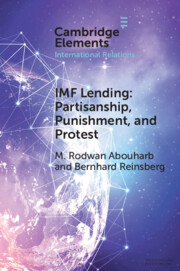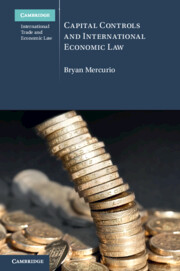Refine search
Actions for selected content:
33 results

Greening the International Monetary Fund
-
- Published online:
- 10 October 2025
- Print publication:
- 06 November 2025
-
- Element
-
- You have access
- Open access
- HTML
- Export citation

China and the Global Economic Order
-
- Published online:
- 10 October 2025
- Print publication:
- 31 January 2026
-
- Element
-
- You have access
- Open access
- HTML
- Export citation
6 - Systemic Capital Market Risks and the Politics of Improvisation
-
- Book:
- Insuring States in an Uncertain World
- Published online:
- 13 August 2025
- Print publication:
- 18 September 2025, pp 128-169
-
- Chapter
- Export citation
Argentina’s creditworthiness achievements and problems, 1955–1962: the role of institutions, policymakers, and external agents
-
- Journal:
- Revista de Historia Economica - Journal of Iberian and Latin American Economic History , First View
- Published online by Cambridge University Press:
- 12 September 2025, pp. 1-21
-
- Article
- Export citation
Under Cover: Substituting Formal IOs during Hard Times
-
- Journal:
- Ethics & International Affairs / Volume 39 / Issue 2 / Summer 2025
- Published online by Cambridge University Press:
- 22 August 2025, pp. 130-144
-
- Article
-
- You have access
- Open access
- HTML
- Export citation
13 - The Enforcement of Extraterritorial Sanctions
- from Part III - Secondary Sanctions and International Economic Law
-
-
- Book:
- The Cambridge Handbook of Secondary Sanctions and International Law
- Published online:
- 14 December 2024
- Print publication:
- 12 December 2024, pp 287-304
-
- Chapter
- Export citation
Do the Bretton Woods Institutions promote economic transparency?
-
- Journal:
- Political Science Research and Methods / Volume 13 / Issue 2 / April 2025
- Published online by Cambridge University Press:
- 24 October 2024, pp. 354-372
-
- Article
-
- You have access
- Open access
- HTML
- Export citation
Chapter 22 - Global economic institutions
- from Part 4 - The new agenda: Globalisation and global challenges
-
-
- Book:
- An Introduction to International Relations
- Published online:
- 31 August 2024
- Print publication:
- 12 August 2024, pp 296-308
-
- Chapter
- Export citation
Certain Iranian Assets (Iran v. United States)
- Part of
-
- Journal:
- American Journal of International Law / Volume 118 / Issue 1 / January 2024
- Published online by Cambridge University Press:
- 29 January 2024, pp. 145-153
- Print publication:
- January 2024
-
- Article
-
- You have access
- Open access
- HTML
- Export citation

IMF Lending
- Partisanship, Punishment, and Protest
-
- Published online:
- 16 November 2023
- Print publication:
- 31 October 2024
-
- Element
-
- You have access
- Open access
- HTML
- Export citation
3 - Habit Not Heredity
- from Part I - General
-
-
- Book:
- The Spread of the Modern Central Bank and Global Cooperation
- Published online:
- 02 November 2023
- Print publication:
- 16 November 2023, pp 57-79
-
- Chapter
- Export citation
Varieties of Just Transition? Eco-Social Policy Approaches at the International Level
-
- Journal:
- Social Policy and Society / Volume 22 / Issue 4 / October 2023
- Published online by Cambridge University Press:
- 13 October 2023, pp. 730-746
- Print publication:
- October 2023
-
- Article
-
- You have access
- Open access
- HTML
- Export citation

Capital Controls and International Economic Law
-
- Published online:
- 18 May 2023
- Print publication:
- 01 June 2023
2 - Bilateral, Regional and Multilateral Investment Agreements and Investment Contracts
-
- Book:
- An Introduction to International Investment Law
- Published online:
- 14 March 2023
- Print publication:
- 09 February 2023, pp 34-69
-
- Chapter
- Export citation
1 - Leniency in Asian Competition Law
- from Part I - Introduction
-
-
- Book:
- Leniency in Asian Competition Law
- Published online:
- 15 September 2022
- Print publication:
- 22 September 2022, pp 3-34
-
- Chapter
- Export citation
7 - China and the Liberal International Order
-
- Book:
- Ascending Order
- Published online:
- 21 July 2022
- Print publication:
- 04 August 2022, pp 246-280
-
- Chapter
- Export citation
Chapter 7 - Among Economists
- from II - International Economist, 1948–1976
-
- Book:
- Money and Empire
- Published online:
- 11 June 2022
- Print publication:
- 04 August 2022, pp 156-184
-
- Chapter
- Export citation
14 - International Economic Law
- from Part II - The Branches of Public International Law
-
-
- Book:
- An Introduction to Public International Law
- Published online:
- 17 February 2022
- Print publication:
- 03 March 2022, pp 276-298
-
- Chapter
- Export citation
14 - International Economic Law
- from Part II - The Branches of Public International Law
-
-
- Book:
- An Introduction to Public International Law
- Published online:
- 17 February 2022
- Print publication:
- 03 March 2022, pp 276-298
-
- Chapter
- Export citation
The road to the 1980s write-downs of sovereign debt
-
- Journal:
- Financial History Review / Volume 28 / Issue 3 / December 2021
- Published online by Cambridge University Press:
- 11 January 2022, pp. 281-299
-
- Article
- Export citation
